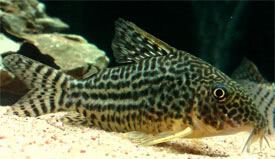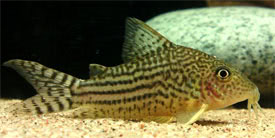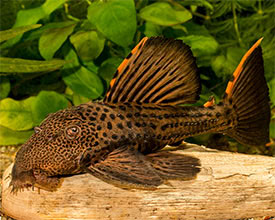
 Magyarul / Hungarian
Magyarul / Hungarian



- Scientific name: Corydoras haraldschultzi
- Common name: Harald Schultz's Cory, Mosiac Cory
- Group: Catfishes
- Habitat: South America; Bolivia, Brazil.
- Size: 7-8,5 cm
- Biotope: Inhabits in the Rio Guaporé and its tributaries, also in flooded forest areas.
- Social behavior: Very peaceful schooling catfish and will do well in a community aquarium. Don’t keep with large or agressive fish.
- Diet: Omnivorous; Frozen and live foods such as bloodworm, white worm, grindal worm, Daphnia and tubifex. Flake foods are also accepted.
- Breeding: Hard
- Tank: Minimum 70 litres
- Population: 6-8 fish for 100 litres
- Decoration: Use river sand or fine gravel as substrate. Decorate the tank with driftwood or twisted grape roots. A few dried leaves are essential if we want to mimic their natural habitat. Use dim lighting.
- Temperature: 24-26 °C
- pH: 6-7.2
- Hardness: 2-15 NK°
- Lifespan: 3-5 years
Description: Corydoras haraldschultzi has a silver body with black dotted pattern. Harald Schultz's Cory is very similar to Corydoras sterbai, but can be distinguished by the pattern on the head: Corydoras haraldschultzi has a light body and head with dark spots, dots and lines, while Corydoras sterbai is exactly the opposite: the body and head are dark with light dots and lines. Also Harald Schultz's Cory has an elongated nose. The dorsal fin, anal fin and tail have dark pattern.
Females are noticeably rounder and broader bodied when viewed from above. Can be bred in a similar way to many other Corydoras species: use soft water and breed them in small groups, with 2-3 males for a female. Feed them with live and frozen foods, and when the female is full with eggs do a 50% water change with cooler water and increase the flow in the tank. The fish will usually lay their 2 mm large eggs on the tank glass, often in an area where water flow is quite high. The number of the eggs can be around 40. Remove the parents as they may eat the eggs. The eggs hatch in 4-5 days. Feed the fry with small live foods. The fry grow relatively fast in a larger tank.















































